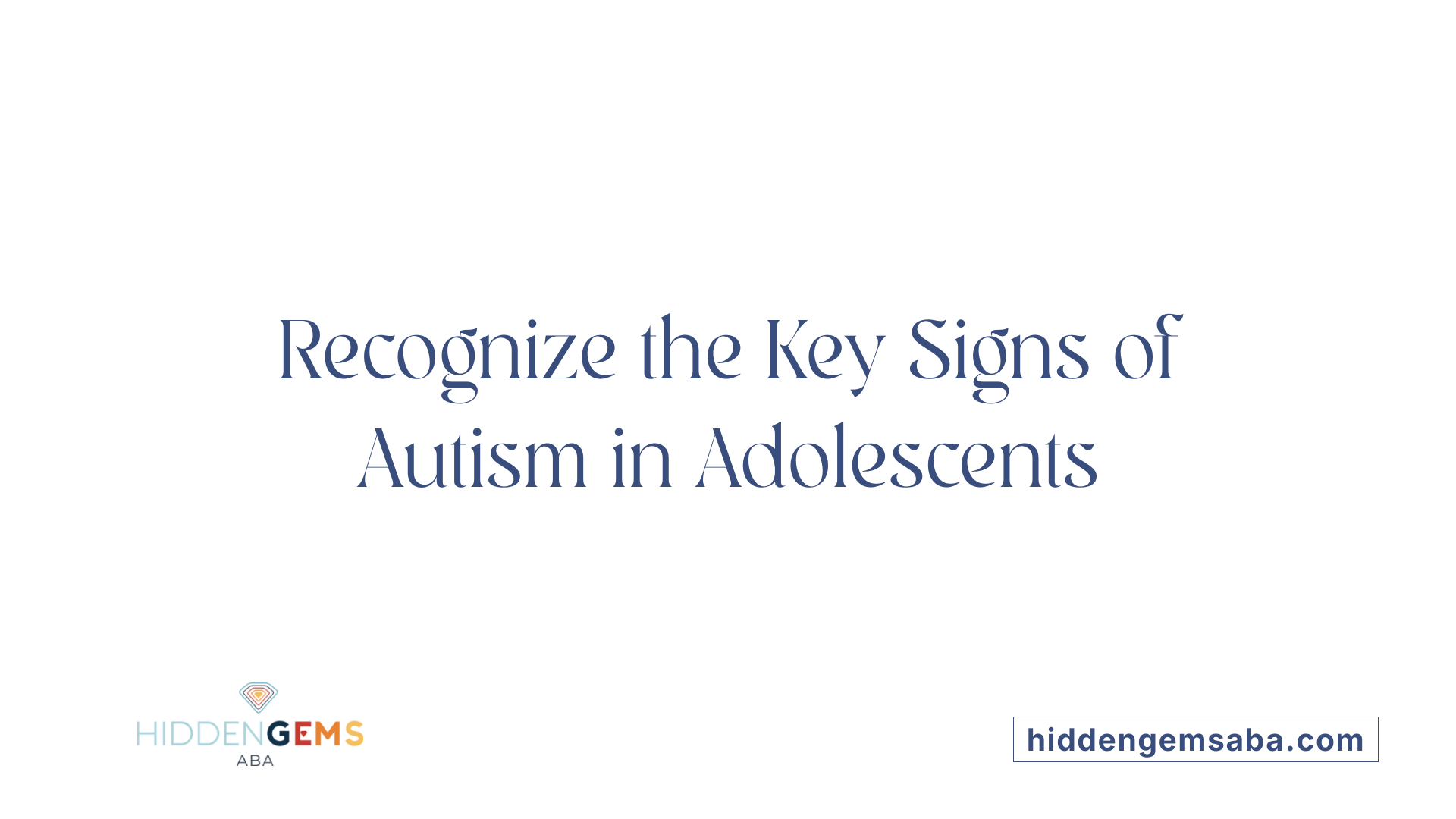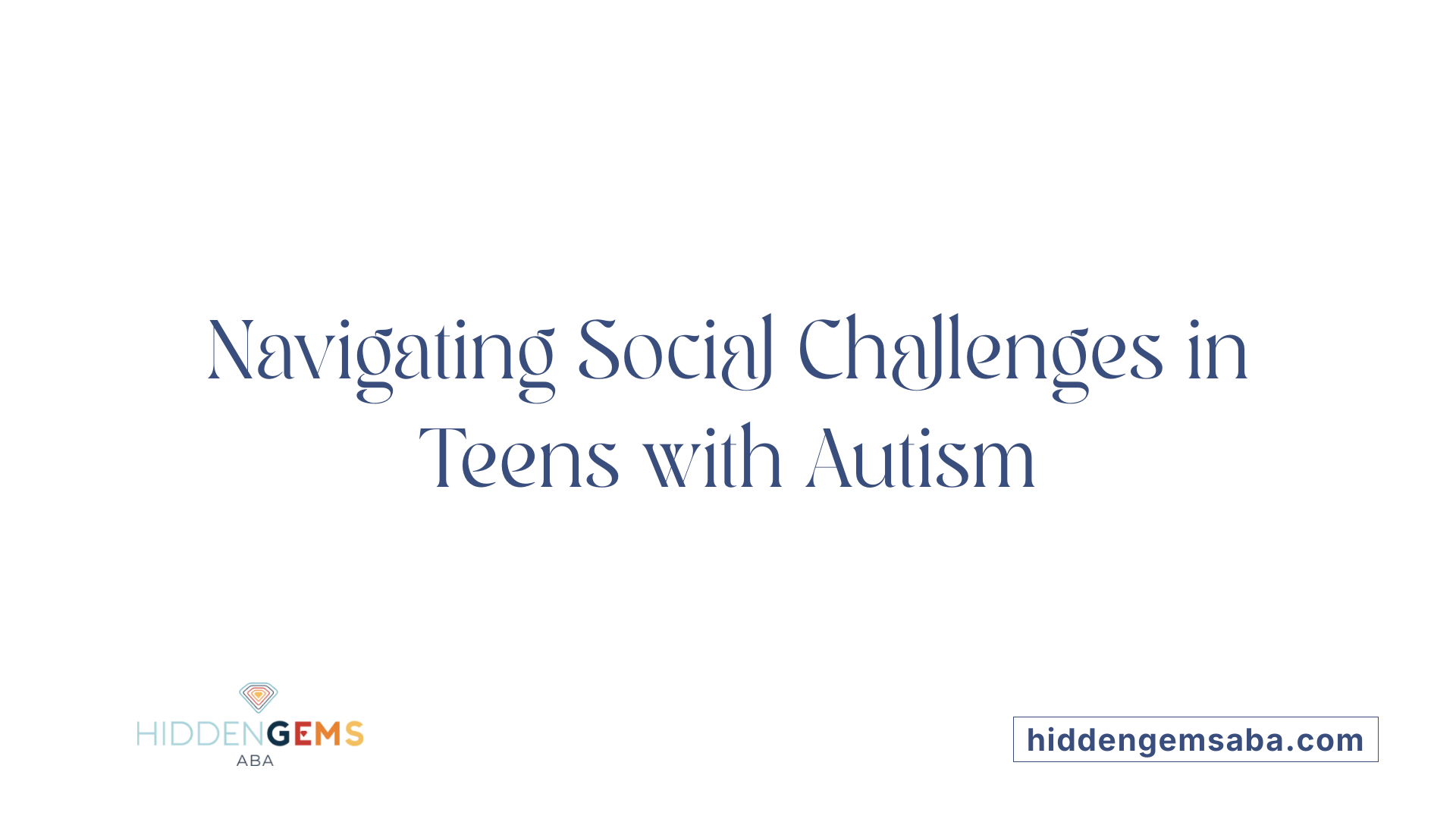Recognizing Autism in Teenagers
Autism spectrum disorder (ASD) manifests uniquely in each individual, with signs often varying by age and gender. During adolescence, autism can present distinct challenges, particularly in social communication and behavior. Early recognition of these signs is crucial for accessing effective support and tailored interventions that enhance quality of life and independence for autistic teens.
Identifying Signs and Symptoms of Autism in Teens

Social communication difficulties in teens with autism
Autistic teenagers often face challenges in social communication, including trouble understanding social cues, difficulty maintaining back-and-forth conversations, and struggles with building and maintaining relationships with peers. They may also find it hard to share interests and emotions or understand others’ feelings and thoughts.
Restricted and repetitive behaviors and preferences
Many teens with autism display restricted or repetitive behaviors. This can include intense focus on specific interests, strict adherence to routines, and sensory sensitivities such as discomfort with certain sights, sounds, textures, or fabrics. Such repetitive behaviors may manifest as repeating words or phrases or engaging in repetitive body movements.
Distinctive non-verbal communication patterns
Non-verbal cues often differ in autistic teens, including limited eye contact and unusual body language. These behaviors can make social interaction more difficult and can be a sign that a teenager is on the autism spectrum.
Challenges understanding social cues, sarcasm, and social rules
Autistic adolescents typically struggle with grasping sarcasm, humor, and unspoken social rules, which complicates social interaction and leads to misunderstandings in conversations.
Common behaviors such as limited eye contact, repetitive speech, sensory sensitivities
Observable signs include limited or fleeting eye contact, echolalia (repetition of words or phrases), and sensory sensitivities, such as being overwhelmed by specific textures or sounds. These are common markers used by clinicians to identify autism in teens.
Executive functioning challenges including planning and organizing
Teenagers with autism may face difficulties in executive functioning skills like planning, organizing, and flexible thinking. These challenges can impact their daily routines, academic performance, and social interactions.
Differences in presentation between genders and masking behaviors in autistic girls
Autism may present differently across genders. Girls and young women often mask or camouflage their symptoms by imitating peers to hide their difficulties. This can delay diagnosis and increase risks for mental health issues, as their struggles may be less noticeable compared to boys.
| Symptom Area | Description | Impact on Teen |
|---|---|---|
| Social Communication | Trouble understanding and using verbal/nonverbal cues | Difficulty maintaining friendships and conversations |
| Restricted Behaviors | Rigid routines, focused interests | Resistance to change and intense engagement with specific topics |
| Non-verbal Communication | Limited eye contact, unusual gestures | Challenges in social bonding and nonverbal reciprocity |
| Understanding Social Rules | Difficulty with sarcasm, humor, and social norms | Misinterpretation of social interactions |
| Executive Functioning | Planning and organization difficulties | Trouble with schoolwork, daily tasks, and time management |
| Sensory Sensitivities | Over- or under-sensitivity to stimuli | Avoidance or distress in common environments |
| Gender Differences and Masking | Girls may hide symptoms, leading to late diagnosis | Increased anxiety and mental health concerns |
Challenges in Social Interaction and Communication

Difficulty understanding and using verbal and nonverbal communication
Teenagers with autism spectrum disorder often struggle to grasp both verbal and nonverbal forms of communication. This includes having trouble interpreting gestures, facial expressions, and tone of voice, which can lead to misunderstandings in social situations. These difficulties extend to limitations in using speech effectively during interactions.
Trouble initiating or maintaining conversations and social relationships
Autistic teens frequently find it challenging to begin and keep up back-and-forth conversations. They may hesitate to start conversations or may not respond appropriately during exchanges, impacting their ability to form and sustain friendships. Sharing interests and emotions can also feel difficult, limiting their social connection.
Problems with interpreting body language, facial expressions, and tone of voice
Understanding subtle social cues like body language and sarcastic remarks is commonly problematic. This can result in confusion or misreading others’ intentions, contributing to social withdrawal or anxiety. Difficulties regulating tone of voice further complicate communication.
Atypical speech patterns and conversational difficulties
Some autistic teenagers exhibit unusual speech patterns, such as repeating words or phrases (echolalia) or speaking in a monotone voice. These atypical speech behaviors may cause misunderstandings or make social interactions more challenging.
Impact of social interaction struggles on peer relationships and emotional expression
These social communication challenges affect how autistic teens build and maintain peer relationships. Difficulties expressing feelings and understanding social boundaries can lead to feelings of isolation or frustration. Such struggles may also influence their emotional well-being, highlighting the importance of supportive interventions.
| Aspect | Description | Effect on Teen |
|---|---|---|
| Verbal and nonverbal challenges | Trouble with gestures, facial expressions, tone | Misunderstandings in conversations |
| Initiating/maintaining dialogue | Difficulty starting or continuing conversations | Struggles with making and keeping friends |
| Interpretation of social cues | Difficulty recognizing sarcasm, body language | Confusion and social anxiety |
| Speech patterns | Echolalia, monotone speech | Communication barriers |
| Relationship and emotional impact | Challenges in emotional expression and boundaries | Feelings of isolation, frustration |
Understanding Restricted Interests and Behaviors

What Are Repetitive Movements and Speech Patterns?
Autistic teenagers often display repetitive movements such as hand-flapping or rocking. They may also repeat words or phrases, a behavior known as echolalia. These patterns can provide comfort and help manage anxiety.
Why Is There an Insistence on Sameness and Strict Routines?
Many teens with autism prefer rigid adherence to routines and sameness. Changes in schedule or unexpected events can cause stress and confusion, so routines offer predictability and a sense of control.
How Does Intense Focus on Specific Interests Manifest?
Autistic individuals often develop strong, focused interests in specific topics or activities. This intense focus can lead to deep expertise and strong concentration but may limit flexibility to engage in other activities.
What Are Sensory Sensitivities?
Sensory sensitivities involve heightened or reduced reactions to sights, sounds, textures, or fabrics. For example, a teen might be very sensitive to loud noises or uncomfortable clothing materials, affecting comfort and behavior.
How Do These Behaviors Impact Daily Life and Social Participation?
Restricted and repetitive behaviors can interfere with everyday activities, making adaptation to new environments challenging. Socially, these behaviors can make it harder to interact with peers who may not understand these preferences or reactions.
What Is the Role of These Behaviors in Autism Diagnosis?
Diagnosis requires observing at least two types of restrictive and repetitive behaviors, such as repetitive movements, insistence on sameness, intense interests, or sensory sensitivities. These behaviors are central in distinguishing autism spectrum disorder.
| Behavior Type | Description | Impact |
|---|---|---|
| Repetitive Movements & Speech | Hand-flapping, echolalia | Comfort and stress management |
| Insistence on Sameness | Strict daily routines | Provides predictability, reduces anxiety |
| Intense Interests | Deep focus on niche topics | Can build expertise but limits flexibility |
| Sensory Sensitivities | Reacting strongly or weakly to sensory input | Affects comfort and social engagement |
Applied Behavior Analysis (ABA) Therapy: An Overview

What is Applied Behavior Analysis (ABA) therapy for autism?
Applied Behavior Analysis (ABA) therapy is a scientifically grounded intervention designed specifically to support individuals with autism spectrum disorder (ASD). Its main purpose is to improve social skills, communication, and learning by carefully analyzing and modifying behavior. ABA works by increasing positive behaviors and decreasing behaviors that may be harmful or interfere with learning.
How does ABA focus on enhancing skills?
ABA therapy targets areas such as social interaction, communication abilities, and learning strategies. It helps individuals with autism understand social cues, initiate conversations, and build relationships. By focusing on these areas, ABA aims to promote more effective communication and increased independence.
What techniques are commonly used in ABA?
ABA employs several techniques, including:
- Positive reinforcement: Rewarding desirable behaviors to encourage their repetition.
- Prompting: Providing hints or assistance to help the individual respond correctly.
- Shaping: Gradually teaching new skills by reinforcing closer approximations to the desired behavior.
These strategies are customized based on the individual's needs.
How are ABA programs individualized?
Programs are tailored through comprehensive behavioral assessments conducted by trained Board Certified Behavior Analysts (BCBAs). These assessments help pinpoint specific behaviors to target and identify effective intervention strategies suited to each person’s unique challenges and strengths.
What are common ABA methods?
Two widely used ABA approaches include:
- Discrete Trial Training (DTT): A structured method using clear, step-by-step instructions to teach specific skills in controlled sessions.
- Pivotal Response Training (PRT): A more naturalistic approach occurring during everyday activities, focusing on improving pivotal skills such as initiating communication, which leads to broader improvements.
Is ABA therapy effective?
Research supports that intensive ABA therapy—usually involving 20 to 40 hours per week over multiple years—can substantially improve language skills, social engagement, attention, and academic performance. Many families report increased independence and better quality of life as a result of ABA interventions.
Together, these factors make ABA therapy a widely accepted and effective treatment choice for individuals on the autism spectrum, helping them develop important life skills tailored to their individual profiles.
Designing and Implementing ABA Therapy Programs
How do ABA professionals design and implement therapy programs?
ABA professionals start by conducting comprehensive assessments to pinpoint a child's unique strengths and areas of need. These evaluations often take place in clinical, educational, and sometimes home settings, and can involve a multidisciplinary team to get a thorough understanding of social, communication, and behavioral challenges.
Based on these assessments, individualized and goal-oriented treatment plans are created. The plans focus on enhancing essential skills such as communication, social interaction, daily living, and reducing challenging behaviors. These plans use evidence-based methods including Discrete Trial Training (DTT), which provides structured, step-by-step teaching; Pivotal Response Treatment (PRT), which happens in natural settings to improve critical skills like communication initiation; and the Early Start Denver Model, which integrates developmental and behavioral strategies for young children.
Therapy sessions revolve around measurable objectives and use positive reinforcement techniques to encourage desirable behaviors while minimizing undesired ones. The implementation of these plans is led by Board Certified Behavior Analysts (BCBAs) or trained specialists.
Ongoing data collection is crucial for tracking progress and modifying interventions as needed. This continuous monitoring ensures that therapy remains effective and responsive to the individual's changing needs.
Crucially, parents and caregivers are deeply involved throughout the process; their participation supports skill generalization, maintains safety, and helps in making informed decisions about therapy adjustments.
ABA therapy is versatile in its delivery and can be provided in clinical environments, educational settings, or at home, allowing for tailored approaches that fit the individual’s lifestyle and promote consistent learning across contexts.
Qualifications and Expertise of ABA Professionals
What qualifications should professionals providing ABA therapy have?
Professionals offering Applied Behavior Analysis (ABA) therapy should ideally possess certification as a Board Certified Behavior Analyst (BCBA). Achieving this credential typically requires a master’s degree in applied behavior analysis or a closely related field. Alongside academic training, candidates must complete substantial supervised fieldwork, generally ranging from 1,500 to 2,000 hours.
Specialized training is integral to their preparation, focusing on behavioral assessments, intervention strategies, and accurate data collection methods. Experience working specifically with individuals on the autism spectrum or other developmental disabilities strengthens a practitioner’s skill set.
Licensure mandates vary by region, with some states or countries requiring specific ABA practitioner licenses in addition to BCBA certification.
In terms of professional skills, ABA therapists should demonstrate active listening to thoroughly understand client needs, critical thinking to adapt interventions effectively, and strong ethical practice to uphold treatment integrity.
Ongoing professional development is essential for staying current with advances in autism research and therapeutic techniques. Practitioners who combine robust educational backgrounds, extensive hands-on experience, and continuous training tend to deliver the most effective treatment outcomes for individuals on the autism spectrum.
Benefits of ABA Therapy for Teens with Autism

What are the reported benefits of ABA therapy for individuals with autism?
Applied Behavior Analysis (ABA) therapy offers a range of benefits for teens with autism, significantly enhancing their quality of life and independence. One significant improvement is in communication and social skills. Through behavioral strategies, ABA helps teenagers understand social cues, engage in back-and-forth conversations, and build relationships with peers.
ABA therapy also enhances adaptive daily living skills such as dressing, eating, and personal hygiene. By breaking tasks into manageable steps and using positive reinforcement, teens gain confidence and competence in everyday activities. This leads to greater independence and better preparation for adult life.
A core component of ABA is the use of positive reinforcement to increase helpful behaviors and reduce undesired ones. This approach encourages the development of functional and academic skills by rewarding progress and minimizing obstacles to learning. Therapists use methods like discrete trial training (DTT) and pivotal response training (PRT) to tailor interventions to individual strengths and needs.
Early and intensive ABA intervention has been linked to significant developmental gains. These gains include improved attention, memory, language skills, and executive functioning such as planning and organizing. With consistent support, teens are better equipped to navigate social interactions and prepare for future challenges.
Overall, ABA therapy supports greater social integration, helping autistic teenagers participate more fully in their communities. This multidisciplinary approach fosters honesty, strong focus, and expertise in specific interests, which can be further nurtured through educational and behavioral strategies. As a result, teens with autism experience enhanced well-being and a higher quality of life.
Supporting Teens with Autism: Early Recognition and Tailored Interventions
Recognizing the signs and symptoms of autism in teenagers is key to initiating timely and effective interventions. Understanding the distinct social communication challenges and behavioral patterns can guide families and professionals toward supportive therapies such as Applied Behavior Analysis (ABA). With qualified professionals designing individualized treatment programs, ABA therapy has demonstrated significant benefits, fostering communication skills, independence, and social integration among autistic teens. Early diagnosis, coupled with ongoing support, creates opportunities for autistic adolescents to thrive, highlighting the importance of awareness, education, and compassionate care in their developmental journey.
References
- Autism Spectrum Disorder (ASD) Symptoms & Causes
- Treatment and Intervention for Autism Spectrum Disorder
- Autism symptoms
- Understanding Autism in Kids and Teens
- How Autism May Present at Different Ages
- What Is Autism Spectrum Disorder?
- Applied Behavior Analysis (ABA)
- Applied Behavior Analysis (ABA)
- 6 Benefits of ABA Therapy for Children with Autism





